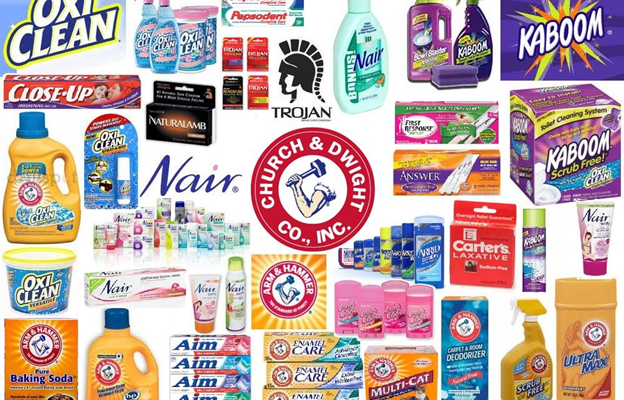“We got the POWER!” Find out how this company succeeded in creating products with one simple base ingredient! [Monday Marketing Marvels]

Baking soda has a lot of uses aside from being a leavening agent in pastries and doughs.
It is also used as a mouthwash, deodorant, air freshener, kitchen cleaner, homemade weed killer, treatment for acid reflux, and many more.
Due to the versatile nature of baking soda, some people have called it “The Miracle Agent.”
For these two brothers-in-law, the ingredient really seemed to have worked its miracle!
Church & Dwight Co., Inc. is an American manufacturer of household products headquartered in Ewing, New Jersey. It is best known for its Arm & Hammer line of products that include baking soda and a variety of products made with it, such as laundry detergent.

The company was founded in 1846 by American manufacturer and businessman John Dwight and his brother-in-law, American medical doctor Austin Church. Their partnership began when they started selling baking soda that they refined in Dwight’s kitchen.
Since then, both of them were acknowledged as pioneer manufacturers of baking soda in the United States.
As of 2020, Church & Dwight Co. Inc.’s consumer products and marketing efforts are focused primarily on its “12 Power Brands,” which are:
- Arm & Hammer
- Oxiclean
- Spinbrush
- First Response
- Nair
- Orajel
- Xtra
- Trojan
- Vitafusion
- Batiste
- Waterpik
- Flawless
Always Aiming to Deliver Outstanding TSR (Total Shareholder Return)
Church & Dwight’s long-term mission is to maintain its track record of delivering “outstanding TSR,” which is based on the Evergreen Business Model. This model enables the company to have a consistent message across its offices and promote financial literacy among its employees.
Here are some of the company’s key drivers of TSR, as included in the Evergreen Business Model:
- Focus on Power Brands
While Church & Dwight sells over 80 brands worldwide, it gives primary focus on its “12 Power Brands” as these brands generate over 80% of the company’s revenues and profits.
- Focus on Gross Margins
Gross margin expansion fuels the company’s growth because it increases investments in marketing, R&D (Research and Development), and technology.
In 2019, Church & Dwight’s gross margin rose by 110 basis points due to productivity improvements, contributions from acquisitions, and price increases. The company also looks forward to launching higher margin new products and buying margin accretive businesses.
- Growth Through Acquisitions
In the past 18 years, Church & Dwight has acquired 11 of its 12 power brands. One of its mottos is:
“12 Power Brands today, 20 tomorrow.”
Church & Dwight believes it possesses a competency in targeting, acquiring, and integrating brands and businesses. It is disciplined in adhering to clear acquisition guidelines and leveraging its existing capital base in manufacturing, logistics, and purchasing.
- Superior Overhead Management
One of the hallmarks of the company is maintaining tight controls on selling, general, and administrative expenses.
Aside from that, Church & Dwight’s top management and employees are committed to further increase the company’s revenues, lower its costs, and provide outstanding customer service.
The company follows an organized system that allows its people to communicate easily, make quick decisions, and adapt to change.
- Simple Incentive Compensation
At Church & Dwight, bonuses are directly tied to its four equally-weighted drivers of TSR―net sales growth, gross margin expansion, EPS (Earnings Per Share) growth, and operating cash flow generation.
The company’s equity compensation consists of stock options that are valuable only when investment value rises. Its senior management team is required to maintain an investment in stock to be closely aligned with stockholders.
“A friend of the environment since the early 20th Century”
Church & Dwight believes in the importance of sustainable business practices. In 1907, it started using recycled paperboards in its product packaging and was the only corporate sponsor of the first Earth Day. It was also the first company to remove phosphate in its laundry detergent products.
In 2019, the company (in partnership with non-profit organization the Arbor Day Foundation) organized tree planting activities to plant millions of trees in the Mississippi Valley.
As of 2020, Church & Dwight’s electricity is derived from renewable resources.
As stated in its 2019 annual report, the company sees sustainable operations as “financially and operationally beneficial to its business and critical to the health of the communities in which [it] operates.”
Church & Dwight’s sustainability platform consists of six pillars that serve as the core focus of its sustainability efforts:
- Brands
- Products
- Packaging
- Employees and Communities
- Responsible Sourcing
- Environment
How Church & Dwight is Handling the Competition
As a company under the CPG (Consumer Packaged Goods) sector, Church & Dwight competes in highly innovative categories that are characterized by a continuous flow of new products and line extensions, and require a significant effort in advertising and promotion.
Some of Church & Dwight’s competitors in the industry are the Procter & Gamble Company (P&G), Colgate-Palmolive Company, S.C. Johnson & Son Inc., Unilever PLC, and Johnson & Johnson.
Church & Dwight competes with these companies on the basis of product innovation and performance, brand recognition, price, value, and other consumer benefits.
The company is aware that some consumer products, such as laundry and dietary supplements, are subject to significant price competition. As a result, Church & Dwight reduces the price of some of its products to respond to competitive and customer pressures as well as to maintain market share.
Church & Dwight has also taken its product innovation to a new level by establishing the Global New Products Innovation Team in 2007. The main job of the team is to introduce new products and product improvements that are designed to delight consumers by satisfying their unmet needs.
This team also works closely with the Brand Marketing, Marketing Research, and R&D teams.
Some of the company’s recent product innovations include Nair’s Wax Ready-Strips, Vitafusion’s Beauty Sleep Gummy Vitamins, L’il Critters’ Despicable Me Complete Multivitamin Gummies, and Arm & Hammer’s Truly Radiant Clean & Fresh Toothpaste.

Church & Dwight’s products are marketed through a broad distribution platform that includes supermarkets, mass merchandisers, wholesale clubs, drugstores, convenience stores, home stores, pet stores, websites, and other e-commerce channels.
In the past five years, Church & Dwight Co., Inc. has recorded a revenue of:
- USD 3.4 billion in 2015
- USD 3.5 billion in 2016
- USD 3.8 billion in 2017
- USD 4.2 billion in 2018
- USD 4.4 billion in 2019
With the use of the Evergreen Business Model and its sustainability efforts, Church & Dwight is able to thrive in the global market despite facing pressures from other big companies in the CPG industry.
Church & Dwight Co., Inc.’s Earning Power: Valens Research vs. As-reported numbers
Church & Dwight Co., Inc. (CHD) makes for a great case study that we come back to regularly. One great reason?
The company has proven itself to be a better earning power generator than investors might think.
So, how well has CHD been growing its business in the past years?
The research doesn’t lie—nor do the results. Earning power (the blue bars) continues to show results higher on average than what traditional databases show.

The blue bars in the chart above represent CHD’s earning power (Uniform Return On Assets). CHD has seen robust, generally improving profitability. Its Uniform ROA ranged between 18% to 46% in the past sixteen years, or an average of about 32%. Its Uniform ROA is at 46% in 2019.
The global ROA is just 6%.
The orange bars are the company’s as-reported financial information. If you relied on these numbers, you will see a company with understated profitability. As-reported ROA (return on assets, a measure of earning power) ranges from 8% to 11% in the past sixteen years. Its ROA in 2019 was only at 8%, far lower than its Uniform ROA in 2019.
That’s what you’ll see in Yahoo Finance, Google Finance, and most other databases.
The company’s stock price also performed better than the rest of the stock market over the decade, which we can see in the blue line in the chart below. Its returns have been well above the market.

The numbers show that Church & Dwight has been doing well and making a profit.
According to Matthew T. Farrell, President and CEO of Church & Dwight Co. Inc., employees are the backbone of Church & Dwight’s success. Through their willingness to pitch in and help, their teamwork is seen as one of the hallmarks of the company’s cultural values.
By focusing on addressing consumer demands and staying true to the company’s heritage and organizational principles, employees will not just discover insights that will lead to new products, but also “brands that consumers love.”
About The Dynamic Marketing Communiqué’s
“Monday Marketing Marvels”
Too often, industry experts and the marketing press sing the praises of some company’s marketing strategy.
…Only for the audience to later find out that their product was a flop, or worse, that the company went bankrupt.
The true ROI in marketing can’t be separated from the business as a whole.
What good is a marketing case study if one can’t prove that the company’s efforts actually paid off?
At the end of the day, either the entire business is successful or it isn’t. And the role of marketing is always paramount to that success.
Every Monday, we publish a case study that highlights the world’s greatest marketing strategies.
However, the difference between our case studies and the numerous ones out there, is that we will always make certain that the firm really did generate and demonstrate earning power worthy of study in the first place (compliments of Valens Research’s finance group).
By looking at the true earnings of a company, we can now rely on those successful businesses to get tips and insights on what they did right.
We’ll also study the greatest marketing fails and analyze what they did wrong, or what they needed to improve on. We all make our mistakes, but better we learn from others’ mistakes—and earlier, rather than later.
Hope you found this week’s marketing marvel interesting and helpful.
Stay tuned for next week’s Monday Marketing Marvels!
Cheers,
Kyle Yu
Head of Marketing
Valens Dynamic Marketing Capabilities
Powered by Valens Research
www.valens-research.com




